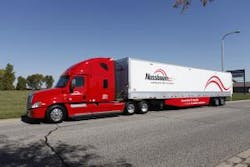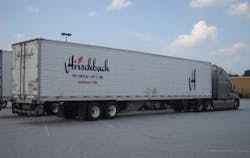Whether they are called transportation management systems (TMS) or fleet management systems (FMS), the goal for such technology in trucking remains the same: generating and delivering data so fleet managers and drivers alike can make faster, wiser and more profitable decisions. The challenge for systems today, however, is to provide what Jim Coffren, vice president-maintenance for Hirschbach Motor Lines, calls more “contextual data,” i.e., data packaged in terms of how it impacts a trucking operation as a whole.
“We need to use data to know where the opportunities are,” he notes, pointing out that up to 20% of a fleet’s vehicles may be under-performing in terms of fuel economy, maintenance costs, etc., simply because the data they get doesn’t paint a broad enough operational picture. “The key is to make decisions that take care of not just the vehicle, but the load and the driver at the same time. A truck down for repairs means a driver doesn’t get a paycheck, and the customer doesn’t get their load on time,” he explains. “That’s why contextual data is so important; we need data on a breakdown in real time because we’ve got 98% on-time delivery requirements.”
Norman Thomas, vice president-operations for CarrierWeb, notes that gaining the ability to actually “view” the driver’s workday via contextual data—to track their activities, routes traveling, and on-time delivery metrics—gives carriers the ability to make real-time adjustments necessary for improving service to shippers while helping reduce their bottom-line costs as well.
“Data can show on-time delivery, quicker transit, less wasted miles, better fuel economy, and fewer delays due to inclement weather and traffic via integrated real-time systems,” he says. “That information can then be utilized to effectively establish and manage [driver] performance or fuel-efficiency bonus plans.”
Brent Nussbaum, CEO of truckload carrier Nussbaum Transportation, says his fleet does exactly that. Data gathered by the company’s PeopleNet system crafts driver scorecards dubbed “Driver Excelerators” that track everything from out-of-route miles and on-time delivery arrivals to vehicle fuel economy and hard braking events. Drivers are paid bonuses of up to $1,800 per quarter if they hit the right numbers.
“We pull data from our trucks to assign points to drivers based on fuel economy, safety, and operational metrics—letting our driver managers use this data to coach, not correct, our drivers to reach the desired targets,” Nussbaum says. “And it’s not about using that data to show them how to do it better; it’s about why we need to do it better, too.”
Rick Ochsendorf, senior vice president-operations at PeopleNet, notes that the creation of such broad-based driver scorecards is one example of how TMS technology continues to evolve over just the last couple of years.
“In the past, companies used to score drivers based on fuel efficiency, but we know that fuel efficiency or miles per gallon data can be skewed based on numerous factors such as the terrain (mountains vs. flat), the age of a vehicle (older vehicles generally are less efficient), the weight of the load being carried, etc.,” he points out. “Now, instead, TMS programs can accurately create scorecards based on shifting, braking, i.e., things the driver can control. This methodology has proven to be a much more relevant and widely accepted tool for measuring drivers based on performance.”
From PeopleNet’s perspective, then, contextual data means providing more correlation between events, and geofencing provides an example of how that correlation occurs. “If the driver arrives on time, [that] triggers an automatic notification to dispatch and also automatic billing so a driver can get properly paid, especially for detention time,” Ochsendorf notes. “Geofencing offers better planning, better visibility of driver hours of service, and can offer drivers loads [for which] they would normally not be considered.”
For example, he points out that with TMS software, fleet managers can see if a driver has hours available in a particular location. If so, and if the driver is on schedule to unload, dispatch can schedule that driver to take on another load. “In the past, similar situations used to result in a loss of approximately $500 to $600 of gross revenue each time dispatch was unsure if a driver would be available for reload with available hours to deliver on schedule,” Ochsendorf explains.
Making TMS function in real time centers on the filtering of data so fleets can manage by exception, says Rick Glasmann, vice president-OEM strategy, sales, and marketing for Omnitracs. In his view, some 90% of the data being generated around commercial trucking operations is simply noise, while the remaining 10% contains “mission-critical” information.
“It’s all about making more informed decisions; about getting the right information at the right time,” Glasmann explains. “For example, data that is red-flagged gets looked at on a daily basis; yellow flags at some point down the line; and green data means you are good to go, so it does not need looking at.”
Integrating data
One issue he believes is slowing this “data-to-information” shift is the continued insistence on maintaining proprietary data among OEMs, suppliers, and fleets alike. “At some point, more of this data needs to be shared in order to boost analytical capability; it can’t all be kept under lock and key,” Glasmann stresses.
Integrating data allows for far better analysis, such as that used in vehicle prognostics. Data trends can be compared and by using information such as fuel economy and historical data, an expected component lifecycle can be generated, allowing fleets to change out components at risk of failure before that failure occurs.
George Dunn, vice president-sales at CarrierWeb, adds that having enough data to make better fleet decisions is getting increasingly common, though it’s often to the point of too much data these days. “The challenge is having it presented in a usable and impactful way with flexibility to change as the carrier changes and priorities change,” he says. “[That’s why] FMS products have to be tailored and modified as carrier strategies and needs change.”
The challenge for FMS vendors and software companies is getting a trucking company to articulate what is important to them and what specific data they need to run their business better and give them more profitable insights. “Carriers need to decide on what efficient is [to them] or ask vendors or industry experts to provide guidance,” he stresses. “Customization can then take place by segmentation, timeliness of data, and measurement thresholds.”
CarrierWeb’s Thomas emphasizes that more information also allows fleets to ask more focused questions: Where is a truck now? Is it moving? Are trailers being utilized to the fullest?
PeopleNet’s Ochsendorf adds that such contextual data can also help fleets work closer with customers to the benefit of both parties. “For example, one thing that is frustrating for a shipper is not knowing if a truck is going to be on time,” he says. “Shippers need to know when their truck is going to arrive and if it is going to be on time. ”
From that same perspective, focused TMS data also helps carriers with internal operational metrics, such as discerning if they are purchasing fuel at the best cost and in the best place and if their drivers are using that fuel as efficiently as possible, CarrierWeb’s Thomas points out.
“With clearly defined data delivered in the proper format a carrier will be better able to show their customer what they are doing, why and how,” he stresses. “Often this will show the customer a higher value to the carrier versus other carriers who do not or cannot provide that type of information.”
FMS slow to take hold for maintenance
Every year, consulting firm Software Advice surveys thousands of managers about the needs and wants revolving around fleet management systems (FMS) aimed at truck maintenance operations. The firm recently analyzed a random selection of 385 fleet survey responses from 2013 in order to uncover a prospective buyer’s most common pain points and their reasons for purchasing new fleet maintenance management systems—if they purchased them at all. Here’s what Software Advice uncovered:
- The vast majority (72%) of those in this random survey sample operate fewer than 100 vehicles, while 28% have 100 or more vehicles and related assets to manage.
- The majority of buyers (60%) use manual methods such as spreadsheets or paper files to manage their fleet.
- A total of 13% use FMS programs; 16% said they have no formal system in place to manage their fleet.
- Nearly 80% of buyers want to improve efficiency by using software to organize data. Almost half of the buyers (48%) specifically stated they would like to purchase a fleet management system to improve efficiency or become more organized; 23% want to begin using software to “go electronic” instead of using more cumbersome paper-based methods for managing their operations.
- Just fewer than 80% of respondents said they specifically want FMS software to help them organize data in a single place for easier retrieval.
- About 11% want to increase the speed of operations by reducing paperwork; another 9% mentioned that they needed to be more proactive with maintenance issues.
When it comes to the “deployment model” for FMS technology, most buyers (79%) are undetermined. Of those who do have a preference, however, 67% are looking for Web-based technology versus 33% who prefer what the firm dubbed an “on-premise” solution.
The firm added that common maintenance management features such as asset tracking and work order management were most requested by fleet buyers seeking FMS programs for their shops.
Excluding those features, the next most commonly requested items included inventory management and reporting, both at 37%, which are typically available either as add-on modules or through separate software that is not specific to fleet maintenance management.
TMS/FMS goal setting is crucial
To get the most out of a transportation management system (TMS) or fleet management system (FMS), suppliers emphasize that motor carriers must establish specific goals or information expectations for those technologies to deliver, explains George Dunn, vice president-sales at CarrierWeb.
Yet to provide data and place it in meaningful context, carriers need to address and establish answers to several key questions:
- What are mpg goals, and how are they segmented? By fleet type (dedicated, long-haul, regional, etc.)? By customer? By lane, region, or terminal?
- Does a fleet’s financial system capture operational costs and pricing? Where do the data points come from?
- Establish strategic objectives for TMS/FMS usage: higher utilization; growth, profitability; improved safety; higher driver retention; maximize driver to non-driver ratio; enter a new niche or business segment (such as temperature-controlled); move towards switching to natural gas fuel; and reduce fuel cost by boasting efficiency and eliminating fuel theft.
- Do you, the carrier, have the expertise to pull it all together? Do you need an outside party to do this? If so, what are your expectations from the vendors?
Fleets also need to provide what Dunn terms “valid measurements” to establish their own true and unaltered base lines to measure improvements and establish trends of key indicators.
“Fleets need to be committed to implementation of FMS technology,” he stresses. “More information correctly displayed leads to better decisions and more options.”
About the Author
Sean Kilcarr
Editor in Chief
Sean Kilcarr is a former longtime FleetOwner senior editor who wrote for the publication from 2000 to 2018. He served as editor-in-chief from 2017 to 2018.




